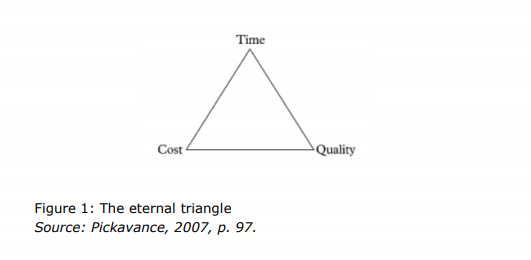
Procurement in the construction sense can be defined as
‘the strategic process of how contracts for
construction work are created, managed and fulfilled’
(Hughes et al., 2015, p. 11).
There are three main procurement methods that are commonly used in the construction industry within the United Kingdom; Traditional, Design and build and Management (Clamp et al., 2012, p. 31). A variety of factors need to be considered when creating a procurement strategy and these are listed below:
- Nature and scope of work proposed
- How the risks are to be apportioned
- How and where the responsibility for the design is to be placed
- How the work is to be coordinated
- What price basis the contract is to be awarded
The needs and objectives of the Client are important to consider when selecting the method of procurement and being clear of what these are will help to choose the most appropriate procurement option (Pickavance, 2007, p. 96). The triangle in Figure 1 illustrates the three priorities which will be important to the Client. Therefore, it is important to discuss with the Client which of the three objectives are most important to them to plan the appropriate procurement route (Pickavance, 2007, p. 97).

Traditional Procurement
The traditional method is a common choice of procurement route where the design and the construction elements are kept separate (RICS, 2014, p. 2). With this method, the Client would appoint expert consultants to advise on the different aspects of design with a professional consultant to be the independent contract administrator (JCT, 2011, p. 2). Once all of the design has been completed, the project would then go out to tender. Unlike other methods of procurement, with the traditional method, all aspects of the design can be controlled by the Client through their appointed consultants (JCT, 2011, p. 2).
Due to the full design of the project being in place before going out to tender, the traditional procurement route can be slower than other methods which some would see as a disadvantage (Pickavance, 2007, p. 117). However, the quality and design can be reviewed and allows for any changes before going to tender to make sure the Client is happy with the project. The cost can be set at the outset which some Clients would prefer and the risks are balanced across those involved which could also be seen as a benefit to the Client (JCT, 2011, p. 2). Traditional procurement is associated with the least risks due to the design, cost and project time being planned from the start (RICS, 2013, p. 7). It is important for the project to run successfully that the design and planning stage is not rushed as this can have negative impacts on time and cost (RICS, 2013, p. 7).
Design and Build Procurement
The Design and Build (D&B) procurement option differs entirely to the traditional route as the contractor is responsible for the design and the construction of the scheme (RICS, 2014, p. 3). Rather than the Client having to appoint different professional consultants, there is only one point of responsibility for the risks over costs and design, this can also reduce costs (Pickavance, 2007, p. 123).
Depending on the contractor and the type of project, their knowledge and experience could be limited and with this option the Client has no direct involvement over the performance of the contractor which also means variations after the contract has been finalised will be difficult and costly (Clamp et al., 2012, p. 46). This procurement route would not be recommended where the Client wishes to have control over the design as the contractor is in control of this aspect (Masterman, 2002, p. 52).
There is an option with the D&B called ‘develop and construct’ (RICS, 2013, p.11) which is where the Client appoints a design team to create the scheme before the contractor then takes over. This does enable the Client to have some control over the design as the contractor works from the prepared design brief. In most cases, the design team would then be novated to the contractor, meaning the contract between the Client and the design team is transferred to the contractor, transferring risk (Hughes et al., 2015, p. 56). The employer’s agent would still remain as the Client’s independent consultant to monitor works, approve valuations and variations etc.
This option is often criticised as being similar to the traditional route with a significant change in the risk apportionment (Hughes et al., 2015, p. 56). With the contractor taking more risk, they usually charge a premium which is often as costly as employing the full design team in the traditional method.
In the main, the D&B option is generally quicker as the design and construction work in parallel (Clamp et al., 2012, p. 46). It is a popular option for standard buildings such as industrial units and also where contractors’ specialist knowledge is needed such as healthcare or laboratories (Pickavance, 2007, p. 123).
Management Procurement
With the management procurement route, the Client will appoint a full team of expert consultants to work on the design of the project, whilst also appointing an independent construction manager whose role is to ‘manage, programme and co-ordinate the design and construction activities and to facilitate collaboration’ (RICS, 2014, p. 4).
The construction manager manages a number of different contractors but is not involved in a contract with them directly, only with the employer (RICS, 2014, p. 4). Therefore, the employers retain a lot of control over the design of the project. This route is similar to the D&B route in that the design and construction can overlap which means works can proceed quicker but it does not provide any cost certainty which could be seen as a disadvantage to certain Clients (JCT, 2011, p. 4). It is also advised that this option only be used when the Client has sufficient experience of construction projects due to their large involvement with this route (RICS, 2014, p. 4). It is also a route more suitable to extremely complex and large projects (Clamp et al., 2012, p. 38) but also where a specialist sub-contractor is not capable or perhaps willing to act as the main contractor.
References: Clamp, H., Cox, S., Lupton, S. and Udom, K. (2012) Which Contract? 5th ed. London: RIBA Publishing. Hughes, W., Champion, R. and Murdoch, J. (2015) Construction Contracts. 5th ed. Oxon: Routledge. Masterman, J. (2002) An Introduction to Building Procurement Systems. London: Routledge. Pickavance, K. (2007) Construction Law and Management. London: Informa Law RICS (2013) Developing a construction procurement strategy and selecting an appropriate route. 1 st ed. London: RICS. RICS (2014) Appropriate Contract Selection. 1st ed. Coventry: RICS.
Download our Introduction to Procurement PDF.



